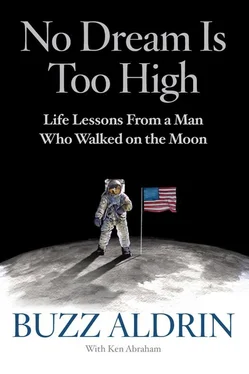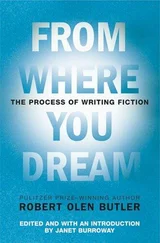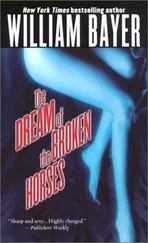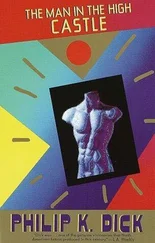“Who is that?” I asked.
“Oh, that’s Neil Armstrong, another test pilot who has been accepted for the astronaut program.”
I had heard plenty of stories about Neil already—that he was a fearless test pilot with a deadpan serious personality. “That’s Neil Armstrong?” I asked, watching the roller skater. He didn’t look too serious to me.
I knew that Neil had been a fighter pilot in Korea as well, so we had that experience in common, and we soon struck up a long, lasting friendship, one that some people would later misunderstand and misrepresent, but a friendship that Neil and I knew was based on mutual admiration. My friendship with Neil Armstrong became another positive factor in my life. Neil and I became even better friends when we were selected to work together as the backup crew for Apollo 8. Neil was a man of few words and enjoyed being the strong, silent type. I, on the other hand, enjoyed talking about our work and the possibilities ahead. But we hit it off and had a mutual respect and appreciation for each other. We were a good team. We worked closely together almost every day for six years, and although one of us would sometimes rub the other the wrong way, we always brought out the best in each other.
Neil and I were selected as the crew for Apollo 11 in January 1969. In some ways, because we were selected for the first landing mission to the Moon, it created an additional strain on our friendship. We both knew there would be enormous publicity around our mission and that everything we said or did would be all over the news. When some people at NASA questioned whether I was the right man for the job, Neil came to my defense. I knew that we worked well together, and I was glad to learn that Neil felt the same way. He was quick to defend a friend, and I’ve always been honored to be known as his co-worker.
Not long ago, I visited Purdue University, where faculty and student researchers have been working with my Mars Cycler ideas—a system of spacecraft cycling between Earth and Mars, continually carrying people and materials in both directions. Outside the Neil Armstrong Hall of Engineering stands a large statue of Neil, who was an engineering student at Purdue in 1955. I slipped up next to the statue and cracked, “Hey, I want them to make a statue of me, sitting here beside Neil and holding his hand!”
Although all of the astronauts in training were extremely competitive, we were also friends. That made sense, because most other people couldn’t really relate to our intense training, our level of commitment to the cause, and how passionately we pursued our goals of catching and passing the Russians in the exploration of space. Like any team, however, some of us clicked with each other better than others. One of the guys that I became closest to was Ed White.
Ed was a year behind me at West Point, and he and I were on the track team together and became best friends during our time at the academy. Ed enlisted in the Air Force upon his graduation in 1952. He spent three years in Germany, and he was stationed there when I arrived at Bitburg following my stint in Korea. I was stationed in Germany from 1956 to 1959, and during that time, our friendship grew even stronger.
Like me, Ed loved flying the F-86 Sabre jets as well as the incredible F-100 fighter jets in the “Big 22 Squadron” that made regular runs close to the “Iron Curtain” nations, the countries under Soviet control. We were carrying a nuclear payload, and we were ready to attack the Russians at the first sign of a nuclear threat. The Russians had already steamrolled into Budapest, crushing any opposition, so we were constantly on alert to halt any further advances by the Soviet forces in Europe. Ed and I regularly flew practice missions, loaded with bombs we were ready to deliver.
Near the end of the decade, Ed became fascinated with space. Leaving Germany, he attended the University of Michigan and earned his master’s degree in aeronautical engineering the same year that NASA selected seven men as the original astronauts for Project Mercury, the first U.S.-manned space program. All seven of the initial astronauts were test pilots, so Ed enrolled in the Air Force Test Pilot School at Edwards Air Force Base in California. He was one of the pilots to fly the planes used for astronauts Deke Slayton’s and John Glenn’s weightless maneuvers, some of the first test flights to see how zero gravity affected humans.
As the Mercury flights concluded, NASA began recruiting a new crop of astronauts for Project Gemini. Drawing from more than 200 applicants, NASA selected Ed White and eight more test pilots: Neil Armstrong, Frank Borman, Charles Conrad, Jim Lovell, Jim McDivitt, Elliot See, Tom Stafford, and John Young. Even among this group of superachievers, Ed stood out from the crowd. Moving to Houston, like several other astronauts including me eventually, Ed and his wife, Pat, bought a home in El Lago, to be close to the Manned Space Center. More than any other person, Ed White was the friend who encouraged me to apply to NASA to become an astronaut.
He first went into space on the Gemini 4 mission, and on June 3, 1965, Ed was the first American astronaut to perform a successful extravehicular activity (EVA), a space walk outside the capsule for 21 minutes. A devout Methodist, Ed carried three religious reminders with him when he stepped out of the hatch—a gold cross, a Star of David, and a St. Christopher’s medal. He later quipped, “I had great faith in myself, and especially in Jim [McDivitt, the mission’s commander], and I think I had great faith in my God … The reason I took these symbols was that this was the most important thing I had going for me, and I felt that while I couldn’t take one for every religion in the country, I could take the three I was most familiar with.”
Besides his incredible courage, Ed had a great sense of humor. Before stepping out in space, using a handheld maneuvering gun and attached to the spacecraft by a tether, Ed checked his 35mm camera equipment three times. He said, “I wanted to make sure I didn’t leave the lens cap on!”
Far too quickly, in Ed’s estimation, his space walk came to an end. “I enjoyed the EVA very much, and I was sorry to see it draw to a close,” he said.
Following his outstanding Gemini EVA, Ed was selected as senior pilot for Apollo 1, scheduled for launch on February 21, 1967, as America’s first mission in the program that would eventually take us to the Moon. Unfortunately, as Ed, Gus Grissom, and Roger Chaffee trained and prepared, it seemed they encountered one setback after another. Finally, everything started to come together, each problem solved, so on January 27, 1967, NASA planned a “plugs out” test, a full dress rehearsal for launch, in which the Apollo 1 capsule would be unplugged from external power while the astronauts practiced emergency escape procedures.
Ed sat in the middle seat, and it was his responsibility to reach above his head with a ratchet to loosen the bolts of the hatch. The hatch door was heavy, but Ed was a strong man and in excellent physical condition. He had practiced the egress drill numerous times, although never within the 90 seconds suggested by NASA’s engineers.
They started the drill around 1 p.m. and encountered more problems, including a communications microphone that would not turn off. The three astronauts were still inside the space capsule, perched atop the enormous Saturn rocket standing on Launch Pad 34, as darkness began to shroud Cape Canaveral.
It was then that something went horribly wrong. With all three astronauts buckled into their seats, and with a highly flammable, 100 percent oxygen–rich atmosphere inside the command module and flowing through their space suits, a fire broke out in the capsule. Investigators later thought the fire was caused by some sort of voltage surge or possibly an electrical short that produced a spark below the left equipment bay under Gus Grissom’s seat.
Читать дальше












